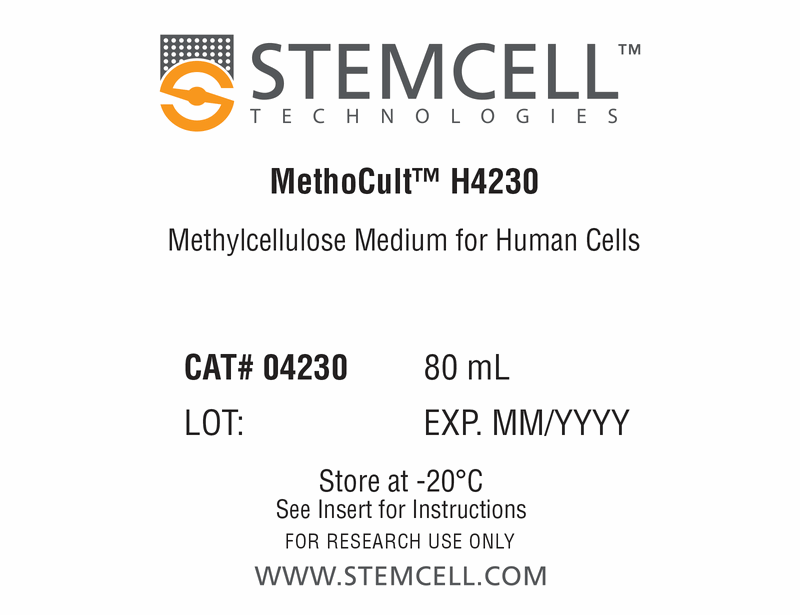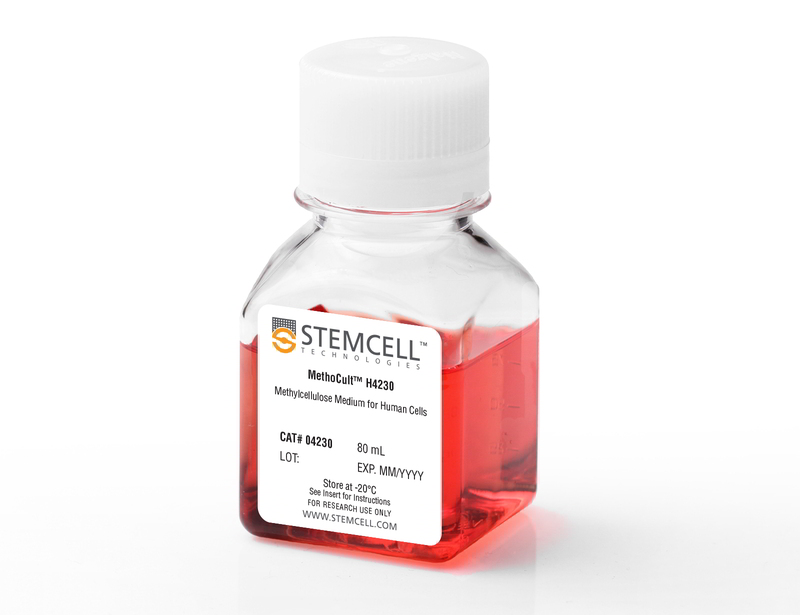MethoCult™ H4230
Methylcellulose-based medium without cytokines for human cells
概要
MethoCult™ H4230 is an incomplete methylcellulose-based medium for the growth and enumeration of hematopoietic progenitor cells in colony-forming unit (CFU) assays of human bone marrow, mobilized peripheral blood, peripheral blood, and cord blood samples. This formulation does not contain erythropoietin (EPO) or other cytokines, allowing the addition of cytokines to meet the specific requirements of investigators.
Browse our Frequently Asked Questions (FAQs) on performing the CFU assay and explore its utility as part of the cell therapy workflow.
Browse our Frequently Asked Questions (FAQs) on performing the CFU assay and explore its utility as part of the cell therapy workflow.
Contains
• Methylcellulose in Iscove's MDM
• Fetal bovine serum
• Bovine serum albumin
• 2-Mercaptoethanol
• Supplements
• Fetal bovine serum
• Bovine serum albumin
• 2-Mercaptoethanol
• Supplements
Subtype
Semi-Solid Media, Specialized Media
Cell Type
Hematopoietic Stem and Progenitor Cells
Species
Human, Non-Human Primate
Application
Cell Culture, Colony Assay, Functional Assay
Brand
MethoCult
Area of Interest
Stem Cell Biology
技术资料
| Document Type | 产品名称 | Catalog # | Lot # | 语言 |
|---|---|---|---|---|
| Product Information Sheet | MethoCult™ H4230 | 04230 | All | English |
| Manual | MethoCult™ H4230 | 04230 | All | English |
| Safety Data Sheet | MethoCult™ H4230 | 04230 | All | English |
数据及文献
Publications (33)
Blood 2020 jun
MYC-induced human acute myeloid leukemia requires a continuing IL3/GM-CSF co-stimulus.
Abstract
Abstract
Hematopoietic clones with leukemogenic mutations arise in healthy people as they age, but progression to acute myeloid leukemia (AML) is rare. Recent evidence suggests that the microenvironment may play an important role in modulating human AML population dynamics. To investigate this concept further, we examined the combined and separate effects of an oncogene (c-MYC) and exposure to IL3, GM-CSF and SCF on the experimental genesis of a human AML in xenografted immunodeficient mice. Initial experiments showed that normal human CD34+ blood cells transduced with a lentiviral MYC vector and then transplanted into immunodeficient mice produced a hierarchically organized, rapidly fatal and serially transplantable blast population, phenotypically and transcriptionally similar to human AML cells, but only in mice producing IL3, GM-CSF and SCF transgenically, or in regular mice in which the cells were exposed to IL3 or GM-CSF delivered using a co-transduction strategy. In their absence, the MYC+ human cells produced a normal repertoire of lymphoid and myeloid progeny in transplanted mice for many months but, upon transfer to secondary mice producing the human cytokines, the MYC+ cells rapidly generated AML. Indistinguishable diseases were also obtained efficiently from both primitive (CD34+CD38-) and late (GMPs) cells. These findings underscore the critical role that these cytokines can play in activating a malignant state in normally differentiating human hematopoietic cells in which MYC expression has been deregulated. They also introduce a robust experimental model of human leukemogenesis to further elucidate key mechanisms involved and test strategies to suppress them.
Nature materials 2019 may
Targeted homology-directed repair in blood stem and progenitor cells with CRISPR nanoformulations.
Abstract
Abstract
Ex vivo CRISPR gene editing in haematopoietic stem and progenitor cells has opened potential treatment modalities for numerous diseases. The current process uses electroporation, sometimes followed by virus transduction. While this complex manipulation has resulted in high levels of gene editing at some genetic loci, cellular toxicity was observed. We have developed a CRISPR nanoformulation based on colloidal gold nanoparticles with a unique loading design capable of cellular entry without the need for electroporation or viruses. This highly monodispersed nanoformulation avoids lysosomal entrapment and localizes to the nucleus in primary human blood progenitors without toxicity. Nanoformulation-mediated gene editing is efficient and sustained with different CRISPR nucleases at multiple loci of therapeutic interest. The engraftment kinetics of nanoformulation-treated primary cells in humanized mice are better relative to those of non-treated cells, with no differences in differentiation. Here we demonstrate non-toxic delivery of the entire CRISPR payload into primary human blood progenitors.
Nature 2018 FEB
Population snapshots predict early haematopoietic and erythroid hierarchies.
Abstract
Abstract
The formation of red blood cells begins with the differentiation of multipotent haematopoietic progenitors. Reconstructing the steps of this differentiation represents a general challenge in stem-cell biology. Here we used single-cell transcriptomics, fate assays and a theory that allows the prediction of cell fates from population snapshots to demonstrate that mouse haematopoietic progenitors differentiate through a continuous, hierarchical structure into seven blood lineages. We uncovered coupling between the erythroid and the basophil or mast cell fates, a global haematopoietic response to erythroid stress and novel growth factor receptors that regulate erythropoiesis. We defined a flow cytometry sorting strategy to purify early stages of erythroid differentiation, completely isolating classically defined burst-forming and colony-forming progenitors. We also found that the cell cycle is progressively remodelled during erythroid development and during a sharp transcriptional switch that ends the colony-forming progenitor stage and activates terminal differentiation. Our work showcases the utility of linking transcriptomic data to predictive fate models, and provides insights into lineage development in vivo.
Nature communications 2016
Semi-automated closed system manufacturing of lentivirus gene-modified haematopoietic stem cells for gene therapy.
Abstract
Abstract
Haematopoietic stem cell (HSC) gene therapy has demonstrated potential to treat many diseases. However, current state of the art requires sophisticated ex vivo gene transfer in a dedicated Good Manufacturing Practices facility, limiting availability. An automated process would improve the availability and standardized manufacture of HSC gene therapy. Here, we develop a novel program for semi-automated cell isolation and culture equipment to permit complete benchtop generation of gene-modified CD34+ blood cell products for transplantation. These cell products meet current manufacturing quality standards for both mobilized leukapheresis and bone marrow, and reconstitute human haematopoiesis in immunocompromised mice. Importantly, nonhuman primate autologous gene-modified CD34+ cell products are capable of stable, polyclonal multilineage reconstitution with follow-up of more than 1 year. These data demonstrate proof of concept for point-of-care delivery of HSC gene therapy. Given the many target diseases for gene therapy, there is enormous potential for this approach to treat patients on a global scale.
Stem Cells 2015 APR
Reversible lineage-specific priming of human embryonic stem cells can be exploited to optimize the yield of differentiated cells.
Abstract
Abstract
The clinical use of human embryonic stem cells (hESCs) requires efficient cellular expansion that must be paired with an ability to generate specialized progeny through differentiation. Self-renewal and differentiation are deemed inherent hallmarks of hESCs and a growing body of evidence suggests that initial culture conditions dictate these two aspects of hESC behavior. Here, we reveal that defined culture conditions using commercial mTeSR1 media augment the expansion of hESCs and enhance their capacity for neural differentiation at the expense of hematopoietic lineage competency without affecting pluripotency. This culture-induced modification was shown to be reversible, as culture in mouse embryonic fibroblast-conditioned media (MEF-CM) in subsequent passages allowed mTeSR1-expanded hESCs to re-establish hematopoietic differentiation potential. Optimal yield of hematopoietic cells can be achieved by expansion in mTeSR1 followed by a recovery period in MEF-CM. Furthermore, the lineage propensity to hematopoietic and neural cell types could be predicted via analysis of surrogate markers expressed by hESCs cultured in mTeSR1 versus MEF-CM, thereby circumventing laborious in vitro differentiation assays. Our study reveals that hESCs exist in a range of functional states and balance expansion with differentiation potential, which can be modulated by culture conditions in a predictive and quantitative manner. Stem Cells 2015;33:1142-1152.
Cellular reprogramming 2014 DEC
Generation of human $\$-thalassemia induced pluripotent cell lines by reprogramming of bone marrow-derived mesenchymal stromal cells using modified mRNA.
Abstract
Abstract
Synthetic modified mRNA molecules encoding pluripotency transcription factors have been used successfully in reprogramming human fibroblasts to induced pluripotent stem cells (iPSCs). We have applied this method on bone marrow-derived mesenchymal stromal cells (BM-MSCs) obtained from a patient with $$-thalassemia ($$-thal) with the aim to generate trangene-free $$-thal-iPSCs. Transfection of 10(4) BM-MSCs by lipofection with mRNA encoding the reprogramming factors Oct4, Klf4, Sox2, cMyc, and Lin28 resulted in formation of five iPSC colonies, from which three were picked up and expanded in $$-thal-iPSC lines. After 10 serial passages in vitro, $$-thal-iPSCs maintain genetic stability as shown by array comparative genomic hybridization (aCGH) and are capable of forming embryoid bodies in vitro and teratomas in vivo. Their gene expression profile compared to human embryonic stem cells (ESCs) and BM-MSCs seems to be similar to that of ESCs, whereas it differs from the profile of the parental BM-MSCs. Differentiation cultures toward a hematopoietic lineage showed the generation of CD34(+) progenitors up to 10%, but with a decreased hematopoietic colony-forming capability. In conclusion, we report herein the generation of transgene-free $$-thal-iPSCs that could be widely used for disease modeling and gene therapy applications. Moreover, it was demonstrated that the mRNA-based reprogramming method, used mainly in fibroblasts, is also suitable for reprogramming of human BM-MSCs.


